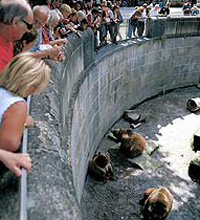 |
|
Bears see little of the world around
them, except the
sky(BBC) | |
After nearly 500 years in a pit, Bern's famous
bears are to get a new home - a riverside reserve on the edge of the old
city.
With luck, the park will open in 2007, bringing to an end years of
protests by angry tourists and animal lovers.
"There are worse bear pits, but the bears are confined, they look up
and can only see the sky," said Mark Rissi of the Swiss Animal Protection
society.
But the money - some 6.9m Swiss Francs (4.5m euro) has yet to be
allocated.
The design for the new 10,000 square-metre park allows the bears to
live outside 24 hours a day.
"Now they are locked in at night," says Mr Rissi. "But evening is when
they are most active."
The bears will be able to hibernate in caves, dig in the
ground and catch fish.
Tourists will still be able to see them - not from the parapet of a
pit, but from an adjacent
bridge over the river Aar.
Bears were first brought to the Swiss capital in 1513, about 300 years
after the city's founder named it after the first animal he killed on a
hunting trip.
The symbol of the bear is on the city's flag, and is widely used for
advertising restaurants, beers and other local attractions.
The conservative Bernese public were not initially enthusiastic about
closing the historical bear pit, especially under pressure.
"They do not like criticism from outside," says Mr Rissi.
But the city was won over by the head of the city's zoo, Bernd
Schildger, and a competition was held to select the best design for the
new park.
The pit itself will become a skating rink.
Now the main obstacle is funding. Local
authorities have yet to vote on the appropriation, which comes after a
period of belt-tightening in the canton of Bern to deal with a huge budget deficit.
(Agencies) |
瑞士“熊城”伯爾尼著名的熊近500年來一直居住在動物園的“熊坑”里,現在它們即將擁有自己的新家——坐落在舊城邊一條河畔的保護區(qū)。
幸運的是,該公園將于2007年開放,從而結束了惱怒的游客和動物愛好者們(對“熊坑”)長達數年的抗議。
“還有條件更差的熊坑,但是(在這里)這些熊被囚禁了,他們抬頭仰望時除了天空什么也看不到。”瑞士動物保護協(xié)會的馬克·里斯說。
但是一筆約為690萬瑞士法郎(約合450萬歐元)的資金尚未到位。
面積為一萬平方米的新公園的設計使這些熊一天24小時都可以生活在戶外。
里斯先生說:“現在,它們晚上會被鎖起來。但那正是它們最活躍的時候。”
這些熊將可以在洞穴里冬眠,可以挖洞,還可以捉魚吃。
游客們仍然可以看到它們,但不是像原來那樣隔著欄桿俯視深坑,而是從阿勒河上鄰近的一座橋上望過去。
伯爾尼最初的統(tǒng)治者用狩獵中殺死的第一只動物來命名這座城市,大約300年后的1513年,熊首次出現在瑞士首都伯爾尼。
熊的標志性圖案出現在伯爾尼的市旗上,并廣泛用于飯店、啤酒和其他當地特色物品的宣傳廣告上。
保守的伯爾尼民眾起初對關閉古老的“熊坑”并不熱心,特別是面臨壓力的時候。
里斯先生說:“他們不喜歡來自外界的批評。”
但是伯爾尼動物園園長說服了整座城市,還舉辦了一場為新公園選擇最佳設計方案的競賽。
原來的“熊坑”將改為一個溜冰場。
現在最主要的困難就是資金的籌集。伯爾尼當局仍需為撥款舉行投票,而為了應對巨大的財政預算赤字,伯爾尼州正處于節(jié)省開支時期。
(中國日報網站譯) |
